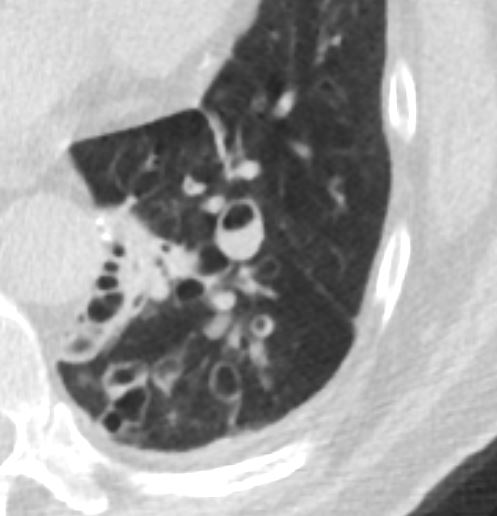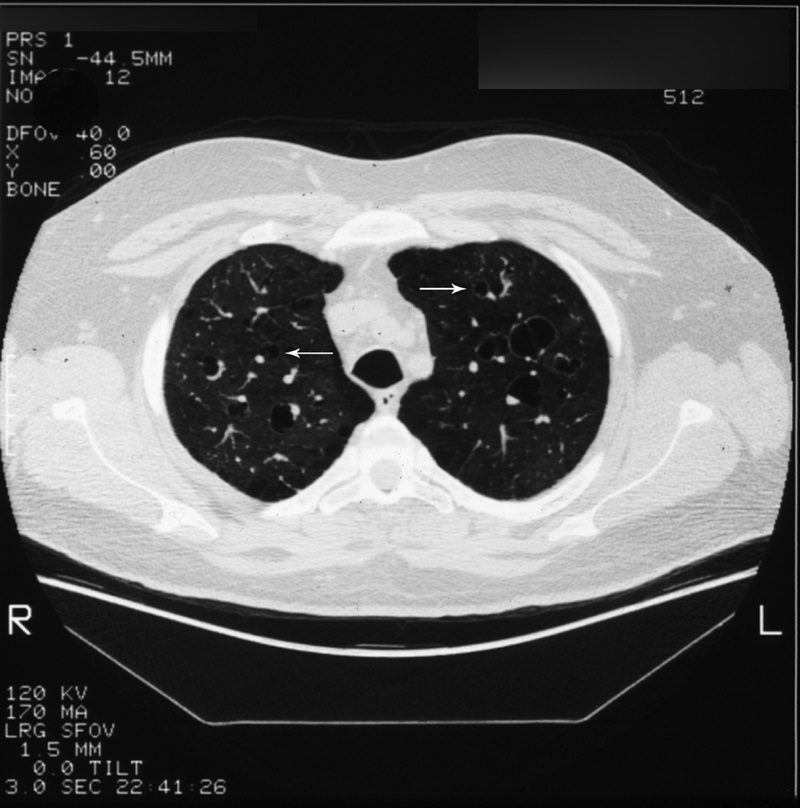Etymology
- Derived from the resemblance of the radiologic appearance to a signet ring, an ornamental ring with a circular bezel often engraved with a seal.
AKA
- None.
What is it?
- The signet ring sign is a radiologic finding characterized by a dilated bronchus (the “ring”) with an adjacent smaller pulmonary artery (the “signet stone”), creating a distinctive signet ring appearance.
- It is a hallmark sign of bronchiectasis.
Characterized by
- Bronchial dilation with a diameter larger than the accompanying pulmonary artery.
- A clear contrast between the larger bronchial lumen and the smaller vessel.
- Visualized most effectively on CT.
Anatomically affecting
- Bronchi and their adjacent pulmonary arteries within the lung parenchyma.
Causes include
- Most Common Causes:
- Post-infectious bronchiectasis (e.g., tuberculosis, bacterial pneumonia).
- Other Causes include:
- Infection:
- Mycobacterium avium complex (MAC).
- Cystic fibrosis-related infections (e.g., Pseudomonas aeruginosa).
- Allergic bronchopulmonary aspergillosis (ABPA).
- Inflammation:
- Chronic obstructive pulmonary disease (COPD).
- Rheumatoid arthritis or other autoimmune diseases.
- Neoplasm:
- Post-obstructive bronchiectasis caused by airway tumors.
- Mechanical:
- Airway obstruction due to foreign bodies or strictures.
- Inherited and Congenital:
- Cystic fibrosis.
- Primary ciliary dyskinesia (Kartagener syndrome).
- Williams-Campbell syndrome.
- Idiopathic:
- Idiopathic bronchiectasis.
- Infection:
Pathophysiology
- Bronchiectasis occurs due to chronic inflammation and structural damage to the bronchial wall, leading to irreversible bronchial dilation.
- The signet ring sign represents:
- Bronchial dilatation beyond the normal bronchial-to-arterial ratio (>1.5:1).
- Compression or underdevelopment of adjacent pulmonary arteries, creating a size mismatch.
Histopathology
- Destruction of bronchial elastic tissue and smooth muscle.
- Chronic inflammation, fibrosis, and mucus plugging within the bronchi.
Imaging
Applied Anatomy
- Parts: Involves the bronchi and adjacent pulmonary arteries.
- Size: Bronchial diameter exceeds the accompanying artery, typically >1.5 times larger.
- Shape: Circular bronchial lumen with smaller, adjacent pulmonary artery resembling a ring.
- Position: In any lobe but most commonly affects the lower lobes.
- Character: Thickened bronchial walls with variable mucus plugging.
- Time: Chronic finding.
CXR
- May show nonspecific signs of bronchiectasis, such as:
- Tram-track opacities (parallel bronchial walls in longitudinal sections).
- Ring shadows in cross-sectional views.
- Atelectasis or consolidation in affected regions.
- Less sensitive compared to CT for detecting the signet ring sign.
CT
- Key Modality:
- Dilated bronchi appear as circular or oval structures.
- The adjacent pulmonary artery is smaller, creating the “signet ring” appearance.
- Bronchial wall thickening may be present, reflecting chronic inflammation.
- Distribution:
- Commonly affects the lower lobes (e.g., post-infectious bronchiectasis).
- Cystic fibrosis may show upper lobe predominance.
- Associated findings:
- Mucus plugging (tree-in-bud appearance).
- Mosaic perfusion indicating air trapping.
- Atelectasis or consolidation.
- Bronchial wall calcification in chronic cases.
MRI
- Limited utility for this sign but may demonstrate:
- Dilated bronchi with increased signal intensity on T2-weighted imaging.
PET-CT
- May show increased metabolic activity in regions with active inflammation or infection (e.g., ABPA, MAC infection).
- Helps differentiate infectious or inflammatory processes from malignancy.
Other
- Ultrasound: Rarely used; may identify mucus-filled bronchi as echogenic structures.
Differential Diagnosis
- Normal broncho-arterial ratio: Mild variations in size can mimic a signet ring but do not exceed the 1.5:1 ratio.
Recommendations
- Further Imaging:
- Chest CT to confirm bronchiectasis and assess the extent of involvement.
- High-resolution CT (HRCT) for detailed evaluation of airway abnormalities.
- Laboratory Correlation:
- Sputum cultures for bacteria, fungi, and mycobacteria.
- Sweat chloride testing for cystic fibrosis.
- Serum IgE levels for ABPA.
- Functional Assessment:
- Pulmonary function tests (PFTs) to evaluate airflow obstruction.
- Bronchoscopy: Considered in cases of suspected airway obstruction or atypical infections.
Key Points and Pearls
- The signet ring sign is a classic radiologic marker for bronchiectasis.
- It reflects irreversible bronchial dilation with adjacent pulmonary artery compression.
- CT is the gold standard for detection and characterization of the sign.
- Cystic fibrosis and post-infectious bronchiectasis are the most common causes.
- Early identification enables appropriate management to prevent complications like recurrent infections.
This radiologic sign highlights the interplay between structure and function, emphasizing how chronic processes can create disproportionate and recognizable patterns.

Ashley Davidoff
TheCommonVein.net

Source
Signs in Thoracic Imaging
Journal of Thoracic Imaging 21(1):76-90, March 2006.
D
Parallels with Human Endeavors
The signet ring sign reflects the concept of imbalance in size and structure, which has parallels in human designs and nature:
- Art: Exaggerated proportions in sculptures and paintings, such as oversized hands or feet in symbolic works.
-

Abughraib by Botero
Indicating disproportionate sized Structures
Fat Man and his Family by Botero
Indicating Disproportionate sSzed Structures - Sculpture
-

Abughraib by Botero
Indicating Disproportionate sized Structures - Jewelry: Traditional signet rings, where a smaller gemstone or engraving contrasts with the circular band.
-

gold-signet-ring-with-virgin-and-child - Architecture: Misaligned columns or structures, creating a visual disproportion.
-

Heydar_Aliyev_Cultural_Center
Indicating Disproportionate Sized Structures - Nature: Asymmetry in growth patterns, such as enlarged plant stems or tree knots due to environmental stress.





